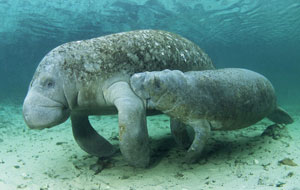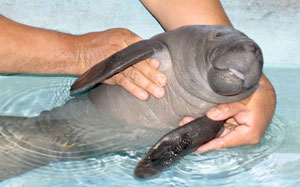 Manatees are commonly referred to as Sea Cows. They are massively cute aquatic mammals — so ugly they’re irresistible and really gentle. Ranging in color from gray to brown, they are covered with wrinkles and short bristle-like hair, and sport long thick whiskers jutting from their snouts.
Manatees are commonly referred to as Sea Cows. They are massively cute aquatic mammals — so ugly they’re irresistible and really gentle. Ranging in color from gray to brown, they are covered with wrinkles and short bristle-like hair, and sport long thick whiskers jutting from their snouts.
Manatee Facts
- Manatees can be found in shallow, slow-moving rivers, estuaries, saltwater bays, canals, and coastal areas - particularly where seagrass or freshwater vegetation flourish.
- There are four species of manatees: the West Indian Manatee, the Florida Manatee (technically a subspecies of the West Indian species), the Amazonian Manatee and the West African Manatee.
- Manatees have fairly good vision and can distinguish between colors.
- Manatees do not have eyelashes. Their eye muscles close in a circular motion, much like an aperture on a camera. They have a lid-like membrane (called a nictitating membrane) that closes over their eyes for protection when they are under water.
- Manatees can hear very well despite the absence of external ear lobes.
- A manatee's heart beats at a rate of 50 to 60 beats a minute. The heart rate slows down to 30 beats a minute during a long dive.
- Manatees have no "biting" teeth, only "grinding" teeth. A manatee's teeth (all molars) are constantly being replaced. New teeth come in at the back of the jaw and move forward about a centimeter a month. The front molars eventually fall out and are replaced by the teeth behind them. This tooth replacement is an adaption to the manatee's diet, as it consumes plants that may hold a lot of sand.
-
Manatees replace worn teeth throughout their lifetime.
- A manatee can move each side of its lip pads independently. This flexibility allows the manatee to "grab" aquatic plants and draw them into its mouth.
- Manatees are herbivores meaning plant eating animals.
- Manatees spend 6-8 hours a day feeding.
- Manatees eat 10% to 15% of their body weight each day.
- Manatees have only six cervical (neck) vertebrae. Most all other mammals, including giraffes, have seven. As a result, manatees cannot turn their heads sideways, they must turn their whole body around to look behind them.
- The manatee's rib bones are solid, there is no marrow. They make red blood cells in their sternum where marrow is found.
- The manatee has pelvic bones, but they are not attached to its skeletal frame. They are remnants of a time when manatees lived on land. The bones are found in a cartilage tissue area of the body in the vicinity of the reproductive organs and the urinary bladder. The bones are soft when the manatee is young and later harden as they mature. Other remnant bones found in the manatee are the hyoid bones located near the neck region. These bones are similar to the Adam's apple in humans. Today, there is no known use of these bones in the manatee.
- The manatee's lungs lie along its backbone instead of along its rib cage as is found in most mammals. The lungs are long (1 meter or more in adults), wide (20 cm), and thin (5 cm or less). Besides breathing, the lungs help the manatee with buoyancy control.
- Manatees surface for air every 3-5 minutes.
- Manatees can stay submerged up to 20 minutes.
- The bones in a manatee's flipper are similar to a human hand. The jointed "finger bones" of the flipper help the manatee move through the water, bring food to its mouth, and hold objects. Three or four nails are found at the end of each flipper.
- The Average Manatee 10ft long weighing 800-1200 pounds.
- They have been known to reach 13 ft and 3500 pounds.
- When born they are 3-4 ft long and 60-70 pounds.
- Manatees closest modern relative is the elephant. Evidence of this relationship is easy to spot – both animals have three to four fingernails.
- Manatees cannot survive in temperatures below 60 degrees (15 Celsius).
-
Females mature for breeding at about 5 years old and 8 years old for males.
-
Manatees are typically pretty slow, but, can swim up to 20 mph.
-
Manatees do not form permanent bonds when breeding.
-
 On average one calf is born every 5 years.
On average one calf is born every 5 years. -
Gestation period is about 1 year long.
-
Manatees babies are born underwater. Mothers must help their calves to the surface so that they can take their first breath. But the infants can typically swim on their own after only one hour.
- Manatees can live up to 60 years old.
- Mothers nurse young for up to 2 years.
- The oldest manatee in captivity is Snooty, at the South Florida Museum. He was born at the Miami Seaquarium on (1948-07-21)July 21, 1948
- Manatees prefer water 3-7 feet deep.
- Manatees range from Virginia to Texas and one was documented in Rhode Island. (Very rare).
- Manatees are marine mammals and breath air through their nostrils.
- Manatees belong to an order of marine mammals called the Sirenians. Dugongs are the other member of this family. Stellar sea cows were also a member of this family, but, they were hunted to extinction within 27 years of their discovery.
-
Fossil remains of Florida manatee ancestors date back about 45 million years.
-
Manatees communicate by squealing under water to demonstrate fear, stress or excitement.
-
The manatee has been linked to folklore surrounding the mermaid legend.
-
Manatees have no natural predators, but, they are peril. Find out more about their plight at Save the Manatees.
Sources:
http://www.savethemanatee.org
http://en.wikipedia.org/wiki/Manatee
http://www.defenders.org/florida-manatee/basic-facts
http://www.seaworld.org/animal-info/info-books/manatee/index.htm
http://myfwc.com/wildlifehabitats/managed/manatee/
